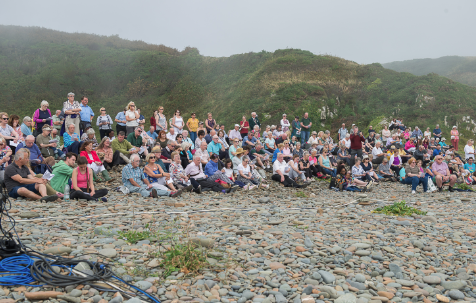September 13 | ![]() 0 COMMENTS
0 COMMENTS ![]() print
print

A proud, public pilgrimage of Faith in Whithorn
Hugh Dougherty explored Scotland’s Catholic history as he joins pilgrims to St Ninian’s cave.
It’s not just the setting of the rocky seashore beside St Ninian’s Cave that makes the annual Galloway Diocese pilgrimage Mass so special, but it’s the fact that this event transports pilgrims right back to the earliest days of Christianity in Scotland.
Although mere Glaswegians, my wife and I are regulars at St Joseph’s, Stranraer during the summer, when we’re staying at our static caravan at Portpatrick. We felt therefore quite entitled to join the pilgrims who head annually for Whithorn on the last Sunday of August, to celebrate Mass and to recall the life and times of St Ninian.
Buses and cars arrive at the vehicle park at the top of Physgill Glen, bringing pilgrims from all across this far-flung diocese.
Far and wide
They come from as far north as Beith and Dalry, as far east as Dumfries, as close to the cave as Whithorn itself, and from all points of the compass in between. That’s just one of the great benefits of this pilgrimage, for not only does it bring the laity together, it also unites the diocesan priests around the altar by the sea, in common purpose.
There is something special about a Mass taken out of its normal home of a church. Maybe, outwith your familiar, Sunday surroundings, you pay more attention, pray more effectively, and feel the Real Presence brought down on to a rocky seashore which St Ninian himself trod in the fourth century AD.
Maybe, too, it’s the sense of faith-affirming unity with all those around you, for, as we wound our way down the glen to the shore, we felt as one. And sitting on the rocks, waiting for Mass to begin, people become chatty, tell you where they’ve come from, and even throw in a life story for good measure!
History
What you’re tapping into is the whole concept of pilgrimage, and you can’t help recalling that St Ninian, famous for founding his Candida Casa, his white house church at Whithorn in 307AD, was a much revered saint right up until the Reformation, the religious revolution of the 16th century.
Pilgrims, ranging from the royal, including Mary Queen of Scots, through all sections of medieval society, including the poor, poured into Whithorn to pray at St Ninian’s tomb, and they came from all over Scotland, England and Ireland, for Whithorn was a major centre of pilgrimage.
Yet, thanks to the crushing of Catholicism by John Knox and his Presbyterian followers, pilgrimages and saints were ruthlessly rooted out of Scotland, and Whithorn became a forgotten place.
Reclaiming identity
An essential part of Scottish religious heritage and practice was snuffed out, just as it was right across the country, but, today, Whithorn has begun to reclaim its identity as a place of pilgrimage, with the Whithorn Pilgrim Way making its way into the tourist guides and websites.
Perhaps, it’s because there’s an innate need in all of us for pilgrimage, to leave the mundane behind, to make a journey, and to do some soul-searching. It’s become fashionable to walk pilgrimage routes, secular-style, but, to do that is to miss the whole point of pilgrimage, which is, as on the beach at Whithorn, to meet God at the end of your journey.
This year, on the beach at St Ninian’s Cave, Bishop William Nolan preached a very excellent homily. He told us that he, like his predecessor bishop of Galloway, St Ninian, had gone to Rome to learn about the Faith, and that he had come back to Scotland to spread that Faith by sharing it with others.
Inspiration
Bishop Nolan reminded everyone around the altar that Faith was for sharing, for taking out into the world, and for gathering around, just as we were gathered in pilgrimage on the rocky seashore, and that we should draw inspiration from St Ninian.
It was a very apt message, a few hundred feet along the shore from the cave in which the saint prayed, and it was a reminder that pilgrimage does not stop at the pilgrimage journey’s end, but that it carries on through life.
A pilgrimage such as St Ninian’s, then, affirms Faith, celebrates it in true community, genuinely brings the Lord to the seashore, and strengthens those present for the next stage of their personal journeys.
Catholic courage
It also shows that as Catholics in secular Scotland today, we have courage and are not afraid to profess our Faith in public, while it reclaims Scotland’s half-forgotten Catholic past: the norm, long before John Knox and his destructive work.
Driving up the road away from the car park, we met, most unexpectedly, a large family group of orthodox Jews, on holiday from England, anxiously scanning a map.
I stopped to ask if I could help, and, yes, they were looking for St Ninian’s Cave. I explained that we were coming from a special, pilgrimage Mass there, pointing them in the right direction.
“St Ninian was a holy man, so we’ll go down,” the father said, thanking me. And, with a wave and a smile, they were off to encounter St Ninian personally.
Pilgrimages can be truly ecumenical, too!










